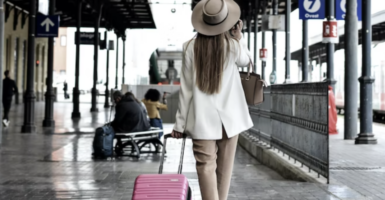How Companies Are Luring Workers Back To The Office
Find out how companies are luring employees back and whether or not their efforts are paying off.
This article is more than 2 years old

America has a problem. Okay, they have more than a single problem, but one of the issues facing the nation is the supply chain issue. If you haven’t heard, businesses big and small across the country are continuing to have a difficult time luring workers back to the office. Help wanted signs decorate companies in big cities and small towns, yet many adults are opting to stay home.
Maybe this issue is a little overstated. Workers are actually finding their way back to work, though much of it still is remote. Since the beginning of the COVID pandemic and normal office work started to shut down, many Americans found themselves working remotely from home. As time went on and Americans began to settle into their new work reality, it became apparent that this new way of work was making them happier and healthier. But now that COVID restrictions are loosening, businesses have been trying to lure workers back into the office instead of working from home.
Some businesses, such as J.P. Morgan, went hardline by telling their employees that remote work was no longer an option. Of course, that didn’t sit well with most, so those in charge backed off from that mandate. Another tact was needed, and many businesses are now trying to be very creative with their ideas in luring workers back.
So, how are businesses attempting to lure workers back into the office? In Uber’s new headquarters in San Francisco, workers are being treated to outdoor terraces, operable windows, and a wellness center that has hanging swing seats for those who wish to get their swing on. One architect who helped design the new building and thus the employee perks claim they designed a floor in the building that overlooks greenery giving employees and their offices a treehouse feel.

A real estate firm in New York City thinks they have a perfect way of luring workers back. They are providing employees with virtual golf links. Set up inside their building, the virtual golf uses cameras along with infrared sensors to help analyze an employee’s golf swing. Nuveen Real Estate’s director of investments Brian Wallick says, via The Guardian, that “adding an amenity like golf simulators helps to foster collaboration as part of a unique user experience, especially in a commercial office building”.
Some companies understand that one of the best ways of luring workers back to the office is through their stomachs. Microsoft has been throwing big lawn parties for those returning employees. The lawn parties offer free tacos, fried chicken, gyros, and the coup de grâce, a beer garden. They also provide a life-size chess board for the Bobby Fischer’s of the company.
Goldman Sachs has decided to step up their food game in luring workers back by bringing in scrumptious food trucks. The trucks offer donuts, lobster, and everything in between. Goldman Sachs is also cranking live music outside its offices. Some of the investment bank offices are offering returning employees free breakfast and lunch with a nice ice cream dessert. They are also giving employees a dinner stipend.
Who’s got a pet? Chances are the pandemic had a number of families bringing home a new furry family member for one reason or another. Well, now companies are luring workers back by allowing them to bring their “best friend” to work with them. Pet-friendly offices are becoming a thing and a number of employers are supplying water bowls, chew toys, and plastic poop bags to make life easier for employees. If bringing in your fur baby isn’t in the cards, some companies are offering a pet stipend which is a monthly reimbursement for things such as cat-sitting or dog-walking.

One last way a company is trying to lure workers back is aimed at those thrill-seekers. One company has decided that to make employees “happy,” perhaps a “happy ending” will suffice. Stripchat, an adult social network firm, is attempting to entice new employees, and current, by creating private pods that allow one to masturbate. Yes, you are reading this correctly. Stripchat is allowing workers to spend up to a half-hour per day (so you better get to it), paid for by the company, inside their “wank pod.” This is an enclosed pod that comes equipped with a super comfortable chair, an Oculus virtual reality headset, lube, lotion, and those very necessary tissues. A Stripchat spokesperson says the company wanted to “provide current and attract new employees with a safe, comfortable space to rub one out”. Obviously, the company will be paying the cleaning bill but weren’t employees warned they told they could go blind?
What companies are really finding out is that these perks are ultimately not what will bring people back to the office. What is luring workers back is the idea of freedom as in choosing when to go in. The pandemic set workers on this path, and it is one that many of them don’t wish to give up. Even as some big businesses are beginning to embrace a hybrid type of work schedule, it may not be enough. Apple is implementing a plan that would start in May and have employees come to the office three days a week. Again, it may not be enough as the idea had one Apple employee say, “Working from home has so many perks. Why would we want to go back?”
Companies are doing what they can to lure workers back. On top of flexible schedules, they are also offering increased paid time off and with some offering unlimited time off, though not sure how that would work. Some are expanding their sick leave, more childcare benefits, and better wellness programs. Some companies are even going the route of four-day workweeks but paying employees for five.
The pandemic had its say and now employees are having theirs. Luring workers back to the office calls for creativity, which many businesses are showing. But will it be enough?







